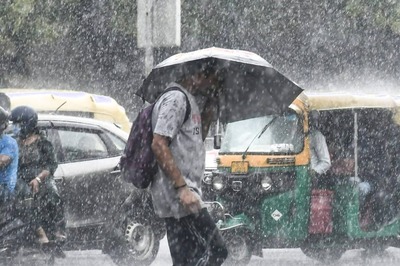
views
Wisconsin’s governor issued an emergency health order on Friday requiring face masks indoors except at home, a move aimed at slowing a surge in coronavirus infections that is pushing hospitals to the limits of their capacity.
The face-covering mandate marked the latest in a flurry of new restrictions by state and local officials nationwide to tamp down COVID-19 cases soaring with the onset of winter.
Public health experts say greater social mixing and indoor gatherings as the weather turns colder ahead of the holiday season is fueling the escalating contagion, threatening to inundate already strained healthcare systems.
“Wisconsin hospitals are overwhelmed and facing staffing shortages,” Wisconsin Governor Tony Evers, a Democrat, said in a press release. His state is one of several in the Upper Midwest registering some of the highest rates of positive results from COVID-19 tests.
The order, which remains in effect for 60 days, requires everyone to wear masks indoors whenever non-household members are present. Children younger than 5 years of age are exempt, as are individuals who have breathing difficulties.
The governor announced the declaration of an emergency hours after one of the nation’s leading public health officials, Dr. Deborah Birx, a member of the White House coronavirus task force, appealed to Americans to avoid unnecessary travel and limit social gatherings during next week’s Thanksgiving holiday.
Birx said more than half the United States has been designated as a COVID-19 “red zone,” where the virus is rampant, and urged Americans to include only immediate family in Thanksgiving celebrations next Thursday.
“This is faster, it is broader and what worries me – it could be longer,” Birx told CNN. “I think it’s on all of us right now to make sure it’s not longer.”
The single-day death toll on Thursday surpassed 2,000 for the first time since late June, according to a Reuters tally of public health data. The seven-day rolling average of daily new COVID-19 cases reached more than 165,000 on Thursday.
FEAR AND HOPE
The number of patients hospitalized with COVID-19 has jumped nearly 50% in the past two weeks, with more than 80,000 people being treated for the disease in hospitals as of late Thursday, the most at any time during the pandemic.
In response, officials in more than 20 states have imposed restrictions to curtail the spread of the virus as hospitalizations climbed to record highs in 29 states in November, straining already exhausted medical staff.
In a positive sign, Pfizer Inc said it would apply to U.S. health regulators for emergency use authorization of its COVID-19 vaccine, the first such application and a major step toward providing protection against the virus.
Pfizer and its German partner BioNTech SE this week reported final trial results that showed the vaccine was 95% effective in preventing COVID-19 with no major safety concerns.
California’s governor on Thursday announced some of the most stringent restrictions on the vast majority of the state’s population, with a curfew on social gatherings and other non-essential activities that will start on Saturday night and end on the morning of Dec. 21.
Similar restrictions took effect in Ohio this week, while Minnesota ordered a shutdown of restaurants, bars, fitness centers and entertainment venues from Friday until Dec. 18 at the earliest.
Emily Kandel, a recruiter and mother of three young children in Columbus, Ohio, said she thought non-essential indoor activities should be generally halted around the clock while schools were allowed to remain open.
“I’m not optimistic that people will adhere to the numerous warnings,” Kandel, 44, said. “I hope they will, but I’m not overly optimistic. I think a lot of people think they are an exception, it’s not going to happen to them.”
In Illinois, where the number of COVID-19 tests coming back positive was at an alarmingly high 20% and new restrictions, including a ban on indoor dining, took effect on Friday, long lines appeared again at testing sites.
In Chicago’s metro area, Emily Randall had no luck finding an opening to get tested after she woke up with a throbbing headache on Thursday.
“It’s very frustrating because I’m trying to be a responsible citizen,” said the 43-year-old research analyst. “My head feels a lot better but I am still worried because I have read stories of people who got better and then, all of a sudden, got worse.”
Although COVID-19 restrictions have received more bipartisan support from state leaders in recent weeks, South Dakota Governor Kristi Noem, a Republican and close ally of President Donald Trump, refused to limit gatherings on Thanksgiving.
“In South Dakota, we won’t stop or discourage you from thanking God and spending time together this Thanksgiving,” Noem said in a statement on Friday.
The University of Washington’s Institute for Health Metrics and Evaluation updated its widely cited COVID-19 forecast model on Thursday, projecting U.S. coronavirus deaths climbing to 471,000 by March.
Disclaimer: This post has been auto-published from an agency feed without any modifications to the text and has not been reviewed by an editor
Read all the Latest News, Breaking News and Coronavirus News here




















Comments
0 comment